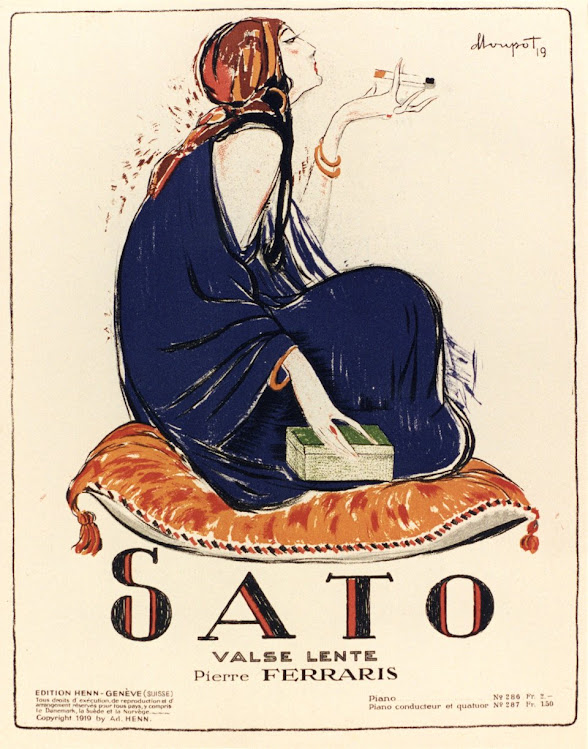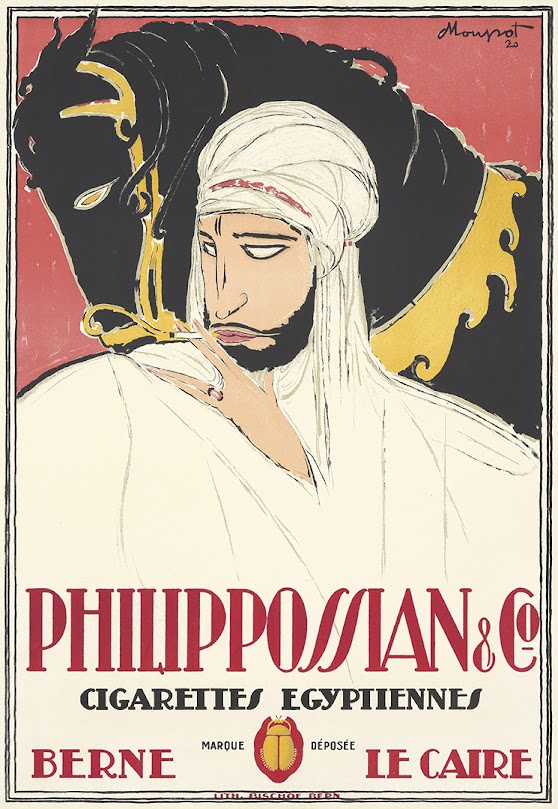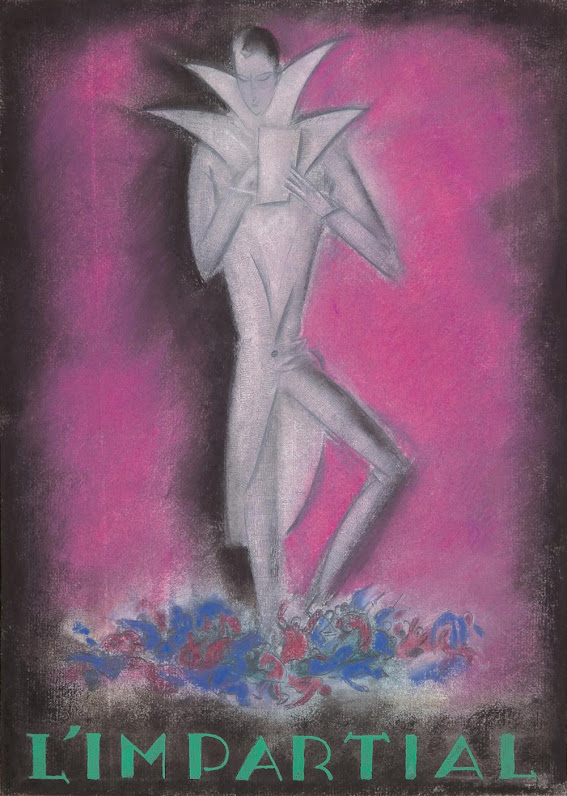Charles Loupot is remembered as one of France’s most influential poster artists of the early twentieth century. Charles Henri Honoré Loupot was born in Nice, France in 1892. In 1911, he took painting lessons and experimented with lithography at the Ecole des Beaux-Arts in Lyon. Loupot was chosen as one of the four official poster artists to represent the 1925 International Exhibition of Modern Decorative and Industrial Arts. Loupot is one of the major creators in the history of the European poster. He is known for his posters for the furniture of the Galerie Barbès, the Voisin cars, Peugeot, Twinning tea, Valentine paintings, Ambre Solaire and above all St. Raphaël and the Canton Furs.
For more in-depth information on Charles Loupot, and for earlier works, see part 1 also.
This is part 2 of a 4-part series on the works of Charles Loupot:
 |
| c1919 Fourrures, F. Canton & Cie. 129 x 90 cm |
 |
| 1919 Savon de Toilette Plantol, pour le Teint 128 x 90 cm |
 |
| 1919 SATO Valse Lente, Pierre Ferraris 34 x 27 cm |
 |
| c1920 Cigarettes Egypiennes, Ophir 30 x 20 cm |
 |
| 1920 Wäschemagazine Metzer 129 x 90 cm |
1920 Philippossian & Co Cigarettes Egyptiennes: A rare, smaller-format version of one of Loupot's most compelling designs. "This Bedouin with slender fingers, with seductive eyes reminiscent of the silent film images, and the black horse all add to the Oriental feel," said Thierry DeVynk. In this case, Loupot had many discussions with the advertiser, Phillipossian, and the black stallion is a personal nod to the industrialist, who was an aficionado of amateur horse racing.
 |
| 1920 Philippossian & Co Cigarettes Egyptiennes 88 x 60.3 cm |
 |
| 1920 Huile Lambert Pour La Bonne Table 128.8 x 89.8 cm |
 |
| 1920 Ch. Philippossian Automobiles, Genève 90 x 127.5 cm |
1920s-30s Oréal: Before the Second World War, L'Oreal was not the international cosmetic giant it has since become, but the hard work of the company's founder, Eugene Schueller, helped turn the company into one of the cosmetic leaders in France. Schueller had a strong belief in the value of advertising and a good eye for innovative creation. Among the top artists he commissioned to work for his company were Charles Loupot and Raymond Savignac. With all of the company's different products, in a field where advertising was essential, L'Oreal commissioned a lot of graphics.
 |
| 1920s-30s Oréal original artwork gouache 31.1 x 24.1 cm |
 |
| 1920s La Plus Économique (Lager) 80 x 60 cm |
 |
| 1920s Caves Petrissans 101.6 x 64.7 cm |
 |
| 1921 PKZ Burger-Kehl & C. 127 x 90 cm |
 |
| 1921 Cailler Chocolat au Lait 128 x 90 cm |
 |
| c1922 Sato, cigarettes Egyptiennes 30 x 20 cm |
 |
| c1922 La femme à la robe rouge et bleue (The woman in the red and blue dress) sketch 28 x 23 cm |
 |
| 1922 Orell Füssli Arts Graphiques, Zurich 128.5 x 91 cm |
 |
| 1922 50ème Anniverssaire Durable Chemises et Col 128 x 90 cm |
1923 Voison Automobiles: In 1923, Gabriel Voisin, the luxury car manufacturer, commissioned Loupot (who had just returned to Paris after years in Switzerland) to design a pair of posters promoting his automobiles. The results are two dramatically different images. This poster is minimalistic, with a small red car against what is essentially an all-white background. The second image is the exact opposite - a colorless car starkly highlighted against a vividly-drawn, verdant forest depicted in a Cezanne-esque style (See Swann sale 2449 Lot 97). The effect these two images had was such that R.L. Dupuy, the head of a prominent Parisian advertising agency at the time, remarked that the posters "dropped like two stones in the frog-pond of the advertising imagination"
 |
| 1923 Voison Automobiles 120 x 80 cm |
 |
| 1923 Les Chaussures Cecil (Cecil Shoes) 158.6 x 113.6 cm |
 |
| 1923 Au Louvre Design to promote the Grands Magasins du Louvre's annual white sale 127 x 92 cm |
 |
| c1924 Two pochoir prints of Art Deco fashion (1) 46.75 x 27.25 cm |
 |
| c1924 Two pochoir prints of Art Deco fashion (2) 46.75 x 27.25 cm |
 |
| 1924 Grand Prix Suisse 14-15 Juin, Geneve 128 x 91 cm |
 |
| 1924 Fourrures Canton 24 Rue de Bourg - Lausanne 128 x 90 cm |
 |
| 1924-25 Frisson D'Automne Manteau de Fourrur (Autmn Shiver) (Fur Coat) 24.75 x 19 cm |
 |
| 1925 Texaco oil, original artwork gouache, ink and crayon 157.7 x 117.4 |
 |
| 1925 Stop-Fire 200 x 128 cm |
 |
| 1925 Parfums L. T. Piver original artwork 154.8 x 115.5 cm |
 |
| 1925 Foire Francfort (Frankfurt Fair) 117.7 x 78.5 cm |
 |
| 1925 Fiera Internazionale, Francoforte (International Fair Frankfurt) 148 x 98 cm |
 |
| 1925 Exposition Internationale des Arts 8.9 x .40 cm |
 |
| 1926 Dauphinet Chocolat Fondant au Lait, Cémoi 160 x 120 cm |






























